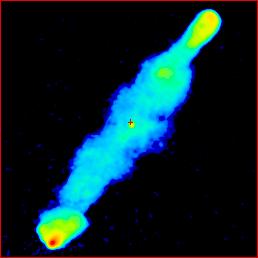 Image:
Image:
The postion of the host galaxy is marked with the red cross; it is coincident
with the radio core. Just south-east of the core is a compact but rather
faint peak, not clearly visible with our LUT because of the low contrast.
This is the only sign of a jet: at higher resolution
Hardcastle et al. (1997) find it to be
extended toward the south-east hotspot.
The two ends of this source are a study in contrasts. To the north-west,
the lobe shows a slight bottleneck structure
(cf. 3C 184.1), and the hotspot at the end
is resolved in our image. To the south-east the lobe expands and
brightens just before the hotspot, giving a mushroom-cap structure.
Hardcastle et al. show that the sharp brightness jump also corresponds
to a sharp change in radio spectrum, from relatively flat in the cap to steeper
in the main bridge (there is a similar spectral edge halfway along the
northern bridge). The south-east hotspot is extremely bright and compact,
with its outer edge still sharp even at Hardcastle et al.'s 0.25 arcsec
resolution.
Possible reasons for the mushroom-cap structure are essentially the
inverse of the ones suggested for bottlenecks (see comments on
3C 184.1); for instance the jet may have
encountered a relatively dense clump, or the engine state may have changed
to produce a beam with more energy but lower density.
Page created: 2009 Apr 2 14:16:43
J. P. Leahy
jpl@jb.man.ac.uk
 Image:
Image: